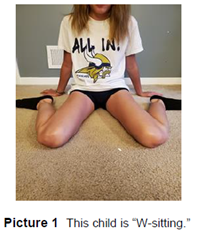Femoral Anteversion

Femoral anteversion (FEM-oral AN-te-ver-shun) is a condition where the femur (thigh) bone rotates inward. This rotation causes the knee and foot to point inward as well. It is known as intoeing or being “pigeon-toed”. Often parents first notice this intoeing when their child begins to walk. It becomes most noticeable around 4 to 6 years of age. Femoral anteversion may exist in one or both legs.
Diagnosis
Femoral anteversion is diagnosed by a thorough exam of the legs, which includes watching the child walk.
Treatment

In the past, femoral anteversion was often treated with braces on the legs. We now know that the braces are not necessary. This condition will usually correct on its own over time, as the child grows. Often by the age of 8 to 10 years of age, it has resolved by itself.
However, in some children, the rotation remains. Persistent rotation can lead to frequent tripping, fatigue, and knee/hip pain. Some children and families are also concerned that their walking and appearance may be different from their peers.
- Children with femoral anteversion often like to “W-sit” (Picture 1). If your child does like to sit like this, encourage them to sit with their legs in front of them or to sit cross-legged.
Femoral Derotational Osteotomy
Sometimes, when the rotation of the femur does not improve, it may lead to problems with walking and pain in the legs. A surgery called a femoral derotational osteotomy may be done to correct femoral anteversion.
The surgery involves separating the femur bone and rotating it to the correct position. The pieces are then held in place by a rod that is inserted inside the bone. The operation usually involves an overnight stay in the hospital after surgery. This allows time to monitor your child’s vital signs, control pain and start physical therapy.
Because of the rod that is in place, children can bear weight or walk as tolerated right away. No brace or cast is needed after surgery. Your child will walk using crutches or a walker, typically for about 4 to 6 weeks. The Physical Therapy Department will provide the crutches or walker and help with crutch or walker training. They will also provide some exercises that your child can work on at home.
Follow-up
When your child is discharged to home, they will have frequent follow up in the Orthopedic Clinic while they are recovering from surgery. They will also be seen by Physical Therapy during these visits. Although your child will be walking without assistance much earlier, it usually takes about 3 to 4 months to see full healing of the bone on an x-ray. Once the bone is healed, the rod can be removed if desired, but the removal is not required. The removal is an outpatient surgery.
HH-I-475 © 2020, Nationwide Children’s Hospital

